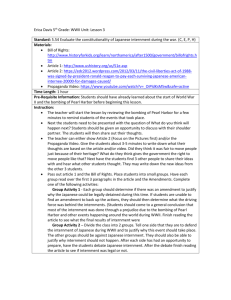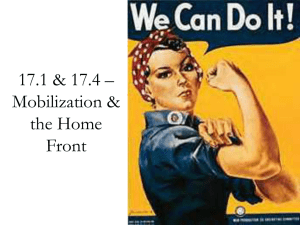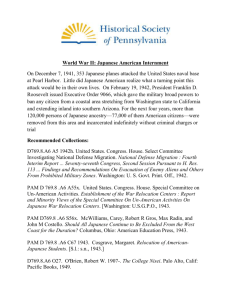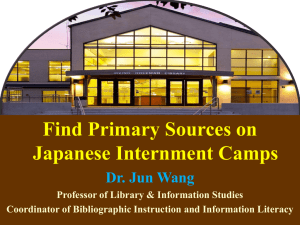Japanese Internment in Colorado - Metropolitan State University of
advertisement
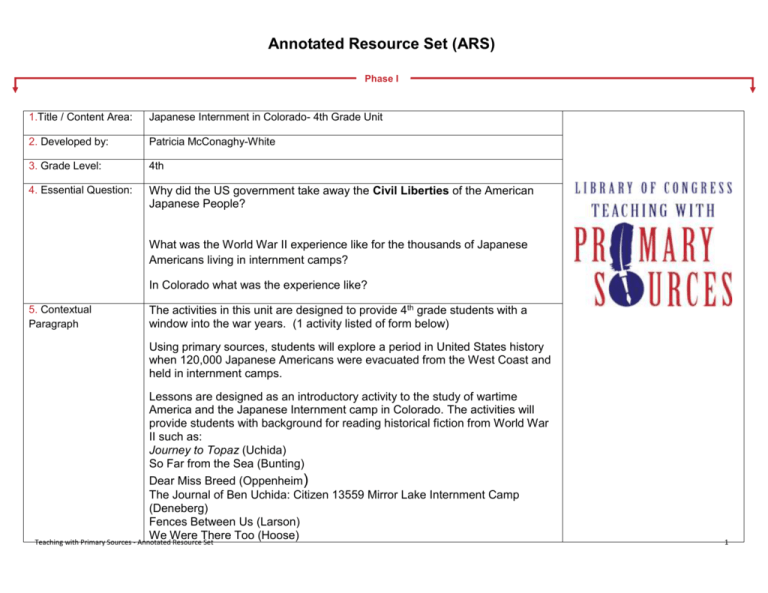
Annotated Resource Set (ARS) Phase I 1.Title / Content Area: Japanese Internment in Colorado- 4th Grade Unit 2. Developed by: Patricia McConaghy-White 3. Grade Level: 4th 4. Essential Question: Why did the US government take away the Civil Liberties of the American Japanese People? What was the World War II experience like for the thousands of Japanese Americans living in internment camps? In Colorado what was the experience like? 5. Contextual Paragraph The activities in this unit are designed to provide 4th grade students with a window into the war years. (1 activity listed of form below) Using primary sources, students will explore a period in United States history when 120,000 Japanese Americans were evacuated from the West Coast and held in internment camps. Lessons are designed as an introductory activity to the study of wartime America and the Japanese Internment camp in Colorado. The activities will provide students with background for reading historical fiction from World War II such as: Journey to Topaz (Uchida) So Far from the Sea (Bunting) Dear Miss Breed (Oppenheim) The Journal of Ben Uchida: Citizen 13559 Mirror Lake Internment Camp (Deneberg) Fences Between Us (Larson) We Were There Too (Hoose) Teaching with Primary Sources - Annotated Resource Set 1 6. Resource Set Children pledging allegiance to U.S. flag at Weill public school, San Fran., prior to relocation School children, Manzanar Relocation Center, California Civilian exclusion order #5 San Francisco, Calif., April 1942. First-graders, some of Japanese ancestry, at the Weill public school pledging allegiance to the United States flag. The evacuees of Japanese ancestry will be housed in War relocation authority centers for the duration of the war 1943 Civilian exclusion order #5, posted at First and Front streets, directing removal by April 7 of persons of Japanese ancestry, from the first San Francisco section to be affected by evacuation http://www.loc.gov/pictur es/item/2001705948 http://loc.gov/pictures/ite m/2002697874 http://loc.gov/pictures/ite m/2001705937 Teaching with Primary Sources - Annotated Resource Set Executive Order 9066: The evacuation of the Resulting in the Japanese-Americans Relocation of from West Coast Japanese (1942) areas under U.S. Army war emergency order Registering JapaneseAmericans upon arrival Issued by President Franklin Roosevelt on February 19, 1942, this order authorized the evacuation of all persons deemed a threat to national security from the West Coast to relocation centers further inland. Los Angeles, California. The evacuation of the JapaneseAmericans from West Coast areas under U.S. Army war emergency order. JapaneseAmericans going to camp at Owens Valley gather around baggage car at the old Santa Fe Station Santa Anita reception center, Los Angeles, California. The evacuation of Japanese and Japanese-Americans from West Coast areas under U.S. Army war emergency order. Registering JapaneseAmericans upon arrival http://www.ourdocument s.gov/doc.php?flash=true &doc=74 http://loc.gov/pictures/ite m/fsa1998003524/pp http://loc.gov/pictures/ite m/fsa1998003584/pp 2 Auction sale sign in Little Tokyo Oakland, Calif., Feb. 1942 Entrance to Manzanar I am an American War Production Board poster (WPB). "Beware Jap-Germs." Challenge to Democracy, 1944 The stocks belong to a Japanese subject to evacuation from West coast areas under United States Army war emergency order Photo attributed to Dorothea Lange Wooden sign at entrance to the Manzanar War Relocation Center with a car at the gatehouse in the background. The store was closed following orders to persons of Japanese descent to evacuate from certain West Coast areas. The owner, a University of California graduate, will be housed with hundreds of evacuees in War Relocation Authority centers for the duration of the war This is one of a series of "JapGerms" posters that were spread through the Westinghouse plant at Bloomfield, New Jersey, under the auspices of the labor-management committee. The two-headed figure, the Jap-Germ, was featured in all posters of the series which warned against sabotage and encouraged the objectives of the war production drive Government-produced film attempting to defend the massive internment of Japanese Americans in concentration camps during World War II. Video http://loc.gov/pictures/ite m/fsa2000049209/pp http://loc.gov/pictures/ite m/2001705924 http://loc.gov/pictures/ite m/2002695960 http://www.loc.gov/pict ures/item/2004665381 http://loc.gov/pictures/ite m/oem2002011650/pp Notes/Comments: Teaching with Primary Sources - Annotated Resource Set 3 Resource Set Amache, Colorado Denver Survey of Resident Japanese & Japanese Americans Amache High School student letters Granada Relocation Center, general order and description http://archives.auraria.ed u/cdp/rpt4.pdf http://archives.auraria.ed u/cdp/rpt7.pdf Teaching with Primary Sources - Annotated Resource Set http://archives.auraria.ed u/cdp/corr.pdf Three high school Ag students with three of their charges Government's latest anti-discrimination poster. -- Denver, Colorado. 7/19/43 Charles E. Mace and Hikaru, in the WRAPS office The students get farm shop credit through part-time farm work at the center farm units. July 7, 1943 Charles E. Mace and Hikaru, in the WRAPS office, prepare more than 1,000 mounted enlargements to distributed in order to promote resettlement. http://archives.auraria.ed u/cdp/chsthumbnails.htm http://www.oac.cdlib.org/ ark:/13030/ft7s200846/?b rand=oac4 National Archives photo no. 210-E-G-811 4 Poston residents Rose Yamanda and Mitsuye Ohye “Remember Pearl Harbor” National Parks Look at WRAPS photographs of resettlers 1942 National Parks Video Internment ID Tag ID_Tag_Blank.pdf Sept 1945 YOUTUBE National Archives photo no. 201-G-K-357 http://www.loc.gov/pictur es/item/2004669768 Teaching with Primary Sources - Annotated Resource Set http://www.youtube.co m/watch?v=XgmY2PxT_Y http://content.cdlib.org/ar k:/13030/tf3j49n6jd/?orde r=7 5 Phase II Foundations Annotations 7. Curriculum Connections Language Arts: Letter writing, Research Social Studies: Us History, Colorado History 8. Curriculum Standards Historical Understanding Standard 2. Understands the historical perspective Language Arts Standard 6. Uses Reading skills and strategies to understand and interpret a variety of literary texts Standard 7. Uses reading skills and strategies to understand and interpret a variety of informational texts Standard 8. Uses listening and speaking strategies for different purposes Standard 9. Uses viewing skills and strategies to understand and interpret visual media US History Standard 25. Understands the causes and course of World War II, the character of the war at home and abroad, and its reshaping of the U.S. role in world affairs Teaching with Primary Sources - Annotated Resource Set 6 9. Content & Thinking Objectives After completing the lesson activities, students will be able to: evaluate documents and photographs from the American Memory collections. explain how major events are related to each other in time. recognize point of view in print and visual materials. Create a letter in the first person narrative from the internment camp in Colorado draw upon primary sources to create a presentation reflective of the Japanese internment experience. 10. Learning Activities & Strategies -Inquiry Learning Activity -Reading two of the picture and historical books -brainstorming activity based on items from resource set - Students create a power point using Primary Sources and present to class 11. Assessment Strategies - Observation sheet filled out -Students demonstrates ability to create a letter in first person narrative relating to the Japanese internment camp in Colorado -Student demonstrates understanding of Japanese Internments camps in Colorado History through a presentation Presentation evaluated by the following rubric: 4 - Excellent: The student's work is historically accurate, is exceptionally detailed, meets or exceeds grade-level requirements for written/oral communication. Presentation is unique and visually outstanding. 3 - Good: The student's work is historically accurate, contains ample detail, meets grade-level requirements for written/oral communication. Presentation is attractive. 2 - Fair: The student's work contains some historical inaccuracies, needs more details, contains many errors in written/oral communication. Presentation lacks quality and attention to detail. 1 - Poor: The student's work contains numerous historical inaccuracies, lacks focus, lacks content. Presentation lacks effort. Teaching with Primary Sources - Annotated Resource Set 7 Other Resources 15. Web Resources Digital Storytelling Project from a TPS Participant from Illinois http://tps.govst.edu/digital_stories/Japanese_Americans.WMV Historic Panama Hotel in Seattle Washington http://www.panamahotelseattle.com/history.htm Amache Digital Collections Project http://archives.auraria.xedu/adc.html http://www.amache.org/Pictures.php National Park Service Report on the Preservation of Japanese American Internment Sites in the US http://www.nps.gov/history/history/online_books/internment/reportd.html President Gerald Ford's Remarks in 1976 Regarding Japanese American Internment http://www.fordlibrarymuseum.gov/library/speeches/760111.htm Japanese American Internment http://www.ushistory.org/us/51e.asp http://newton.uor.edu/Departments&Programs/AsianStudiesDept/asianamintern.html Ansel Adams's Manzanar Photographs: About This Collection http://www.memory.loc.gov/ammem/collections/anseladams/aamabout.html http://www.coloradopreservation.org/epp/sites/epp_01_04.html Children of the Camps: Internment History (PBS) Teaching with Primary Sources - Annotated Resource Set http://www.pbs.org/childofcamp/history/index.html 8 Clare Breed http://www.janm.org/collections/clara-breed-collection/ Woodrow Wilson presidential speech http://www.densho.org/causes/default.asp?path=1racism/1mythsandstereotypes.asp Yatsutake story http://www.densho.org/sitesofshame/index.html Colorado connection Amache (Granada) http://www.densho.org/sitesofshame/facilities.xml The Amache Japanese Internment Camp Through Records at the Colorado State Archives http://www.colorado.gov/dpa/doit/archives/wwcod/granada.htm Densho: The Japanese American Legacy Project - http://www.densho.org/ Children of the Camps: Internment History - http://www.pbs.org/childofcamp/history/index.html JARDA: Japanese American Relocation Digital Archives - http://www.calisphere.universityofcalifornia.edu/jarda/ 16. Secondary Sources YouTube: http://www.youtube.com/watch?v=PxNt45q5sHU http://www.youtube.com/watch?v=bUJD8EPJiwk http://www.youtube.com/watch?v=mNLWKxAMZY4 17. Print and Other Media Resources So Far from the Sea Bunting Journey to Topaz Uchida Dear Miss Breed website http://www.dearmissbreed.com/Index.asp Teaching with Primary Sources - Annotated Resource Set 9 http://www.janm.org/exhibits/breed/title.htm The Journal of Ben Uchida: Citizen 13559 Mirror Lake Internment Camp (My Name Is America ) Fences Between Us Larson ( Dear America ) Baseball Saved Us Deneberg Mochizuki We Were There Too Hoose Weedflower Kadohota ARS Component Guide Phase I Components 1. Title / Content Area: Provide the title of the ARS. If the title doesn’t explicitly denote the sets theme, please also provide a content area (e.g. Environment, Government, Immigration, War/Military, Women’s History, etc.). 2. Developed by: Provide your name and any other contributors to the ARS. 3. Grade Level: Provide the grade level(s) for which the set is to be taught. 4. Essential Question: Provide an essential question that encompasses the set theme and that could be used as a launching point for use in the classroom. 5. Contextual Paragraph for Resource Set: Provide a short paragraph explaining the resource set and describing the context in which the set is to be used 6. Resource Set: Provide titles, context, thumbnails and addresses for the specific resources. It isn’t necessary to provide a thumbnail for all resources (e.g. audio and video files). Important: Be sure to use a permanent URL for all resources (Refer to A2.6). Phase II Components 7. Curriculum Standards: Provide local, state or national standards that could be addressed through the use of the ARS and subsequent activities 8. Curriculum Connections: Provide other curriculum areas to which this set of resources could be applied 9. Content & Thinking Objectives: Provide objectives to be met through the use of the ARS and subsequent activities Teaching with Primary Sources - Annotated Resource Set 10 10. Learning Activities & Strategies: Provide specific strategies and learning activities which the ARS will be used to support 11. Assessment Strategies: Provide assessment methods which will be used to demonstrate student learning after the use of the ARS and subsequent activities Other Resources 15. Secondary Sources: Provide any secondary sources that could be used to supplement the ARS 16. Web Resources: Provide links to any additional web resources that could be used to supplement the ARS 17. Print and Other Media Resources: Provide other resources that could be used to supplement the ARS Teaching with Primary Sources - Annotated Resource Set 11 Learning Activity Procedure Overview The activities in this unit are designed to provide 4th grade students with a window into the war years. Using primary sources, students will explore a period in United States history when 120,000 Japanese Americans were evacuated from the West Coast and held in internment camps. Lesson is designed as an introductory activity to the study of wartime America and the Japanese Internment Camp in Colorado. Preparation ARS set created. Artifact obtained. Copies of Observation forms- paper or on-line Procedure Activity One - Evacuation Day -Group Inquiry Learning Activity Using an artifact and a photograph that contains that artifact in the image, teachers will begin by holding up, and then passing the artifact around. While the artifact is being passed around have students describe it. (I.e.: color, size, shape, weight, etc) Next have them speculate how it was used and who used it? (Their answers can be written in lists on the board). Next bring out the photograph and/or digital image of the photo and have them find the artifact. Next ask them questions such as: Is the artifact being used in the way they guessed it would be? Who is using it? Is there anything in the photograph that they have in their home? What else is going on in the photo? Why and when do they think this picture was taken? What is the historical context of this picture? (What was going on in history when this photo was taken?) Individual Inquiry Activity Give students a copy of the Observation Sheet to record their observations and a second photo from the ARS set. Guiding questions: Is this photograph indoors or outdoors? What objects and/or structures do you see? How many people do you see? Men? Women? Children? How are the people dressed? Are these people family members? Do they relate to each other? Are they touching in any way? What emotions do you see or sense? Anger? Fear? Confusion? Sadness? Joy? Expressionless? Is there something happening in the photograph that might trigger emotions? What is the setting? Where would you place this photo in time and place? Who was taking this photo? Why was this photo being taken? What title would you give this photo? Activity Extensions -Students continue to search for photos about Teaching with Primary Sources - Annotated Resource Setthe books they are reading and create their own ARS set. 12 Teaching with Primary Sources - Annotated Resource Set 13




